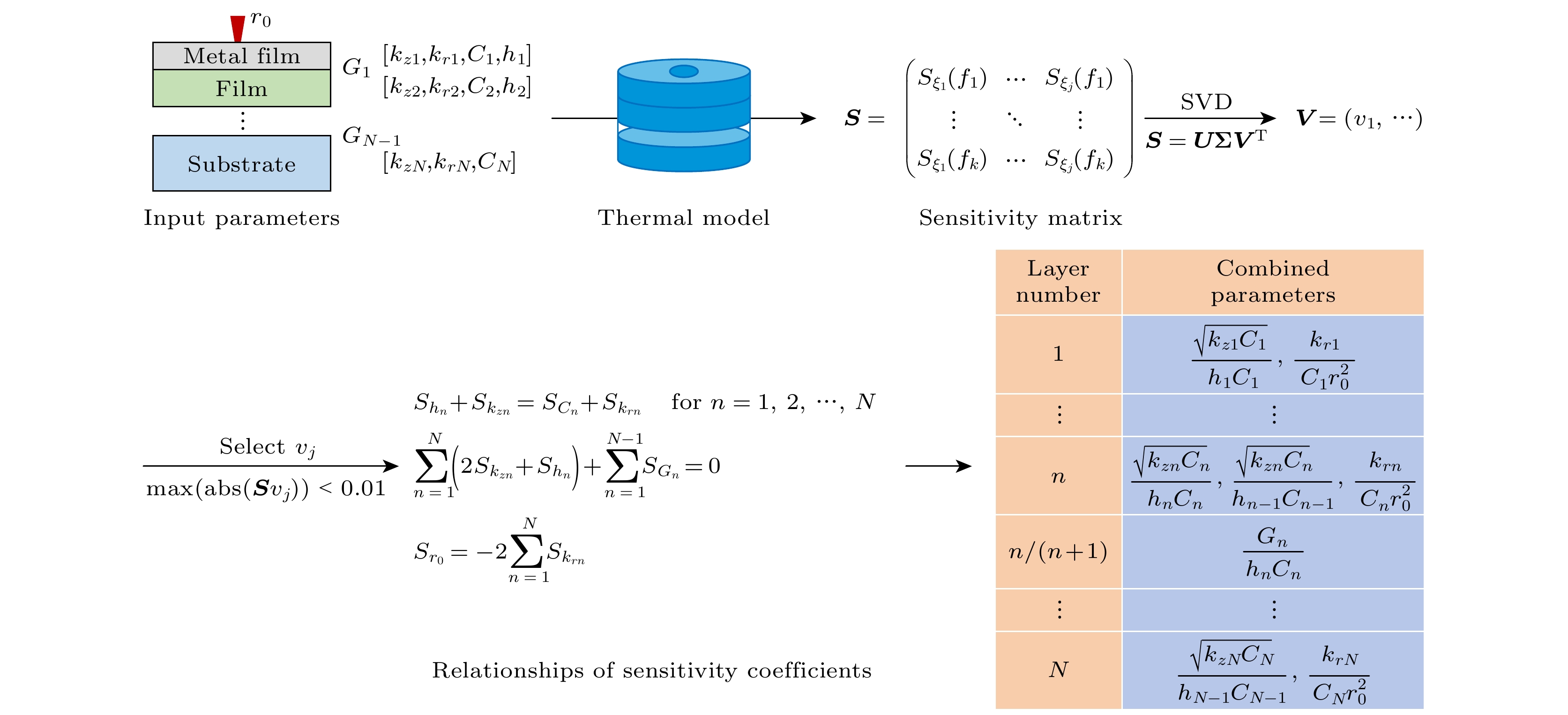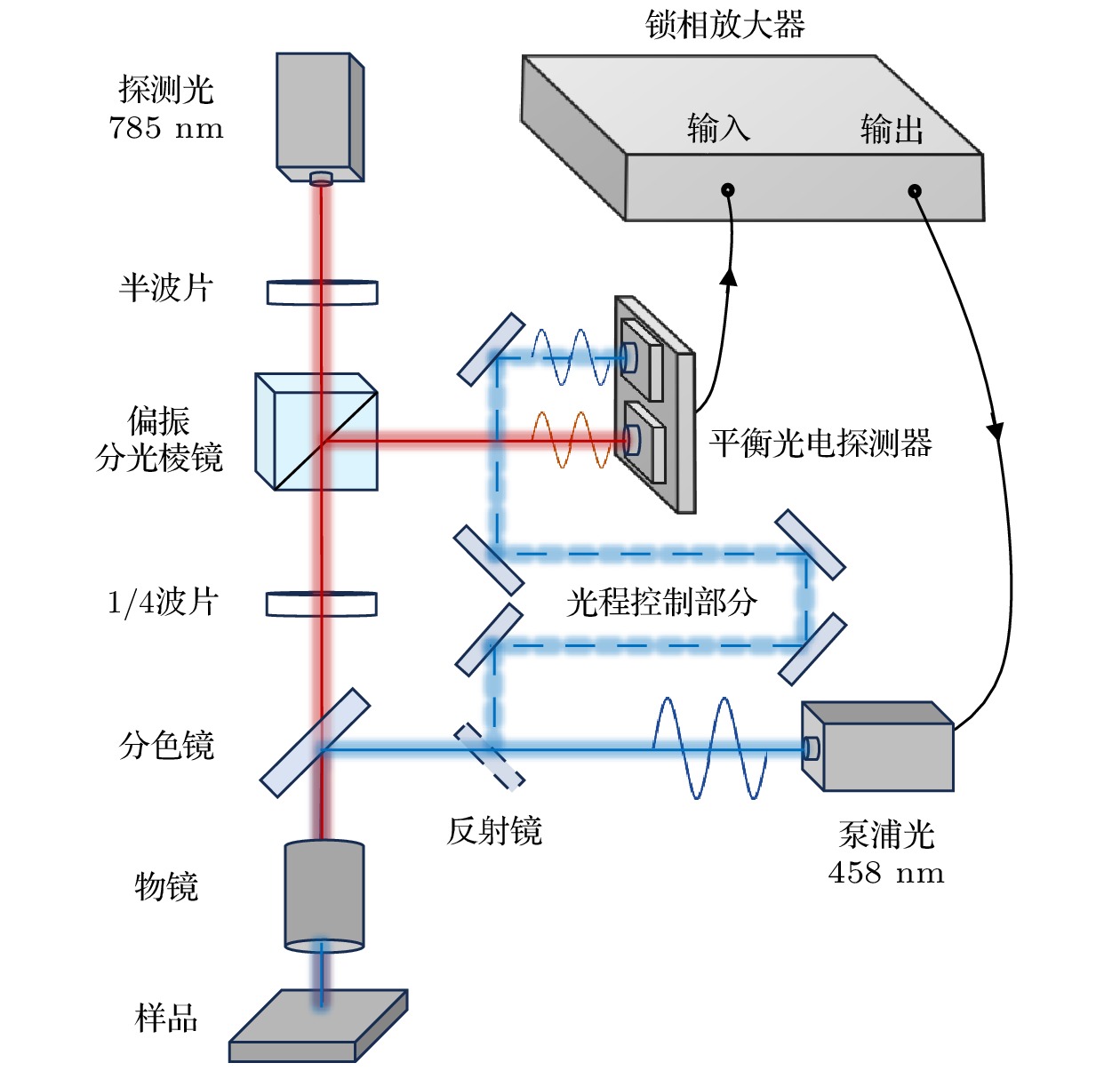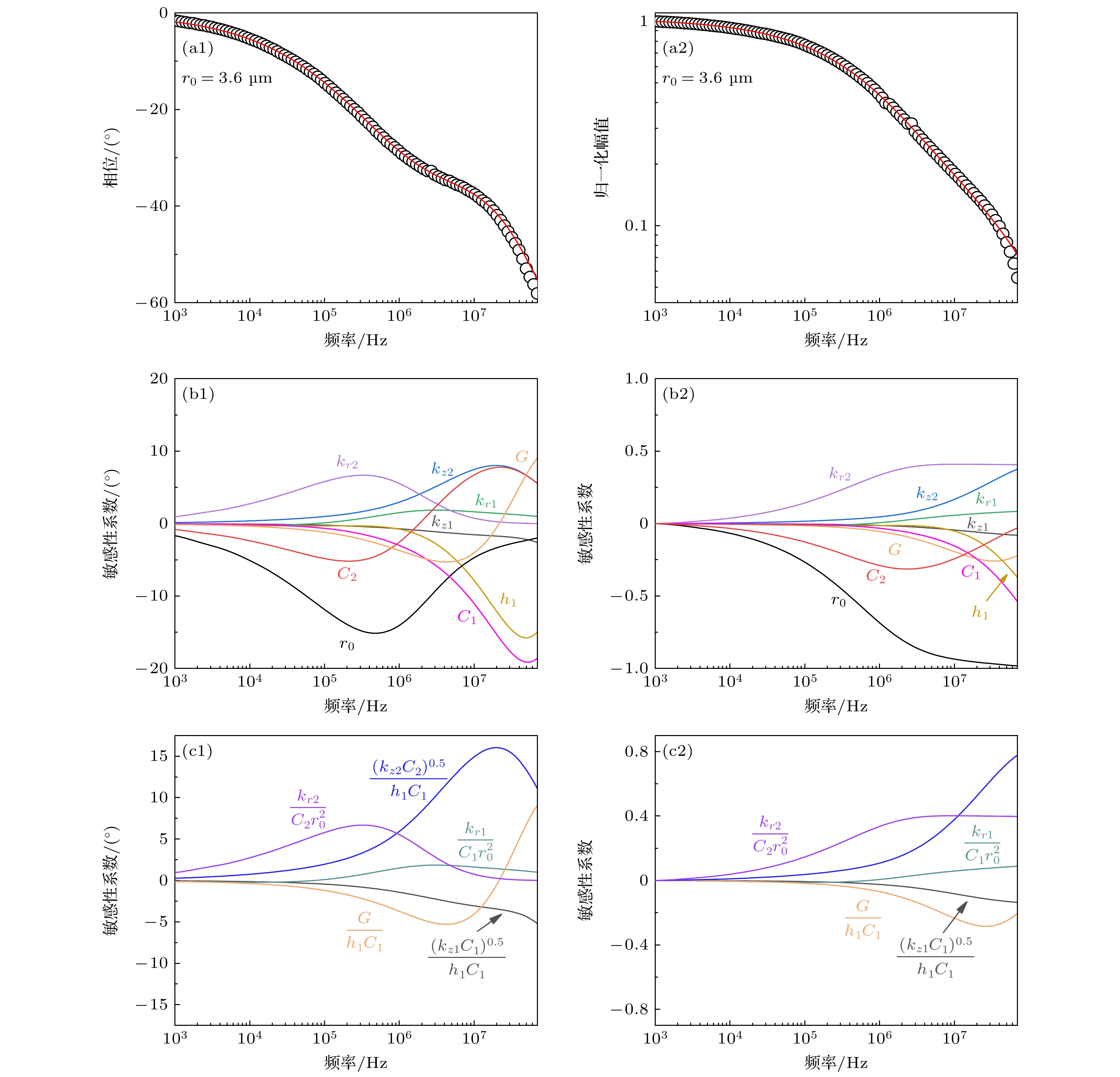-
热反射技术是测量块体和薄膜材料热物性的重要工具, 但参数间复杂的相互关系为数据解析带来挑战. 本文以频域热反射法(FDTR)为例, 利用奇异值分解(SVD)对热反射信号进行了深入分析, 系统地揭示了不同变量之间的关联, 并提出了热反射实验中的关键组合参数. 这种方法不仅厘清了变量间的关系, 还明确了实验中可提取的最大参数数量. 作为应用实例, 本文对铝/蓝宝石样品进行了测量和信号分析, 发现相较于常规仅拟合衬底热导率和界面热导两个参数的做法, 最佳拟合FDTR信号能够同时确定金属膜热导率、衬底热导率、衬底比热容和界面热导四个参数. 拟合结果与文献参考值和其他方法测量结果进行了对比, 验证了该方法的有效性. 本研究深化了对热反射现象的理解, 为热表征技术和材料研究的进一步发展提供了有力支持.Thermoreflectance techniques, particularly frequency-domain thermoreflectance (FDTR), play a crucial role in measuring the thermal properties of bulk and thin-film materials. These methods precisely measure thermal conductivity, specific heat capacity, and interfacial thermal conductance by analyzing the surface temperature response signals through thermoreflectance. However, the complex interplay among parameters presents challenges in data analysis, where single-variable analysis often fails to accurately capture intra-layer and inter-layer interactions. In this work, FDTR is used as a case study and the relationships between sensitivity coefficients of various parameters are systematically explored through singular value decomposition (SVD). Specifically, the SVD of sensitivity matrix S of the system's parameters is performed to identify smaller singular values and their corresponding right singular vectors, which are the basis vectors of the null space of matrix S . These vectors reveal the relationships among parameter sensitivities, thereby uncovering the most fundamental combination parameters that determine the thermoreflectance signal. This method not only clarifies the dependency relationships between variables but also determines the maximum number of parameters that can be experimentally extracted, and the parameters that must be known beforehand. To demonstrate the practical value of these combination parameters, this work conducts a detailed analysis of FDTR signals from an aluminum/sapphire sample. Unlike traditional FDTR experiments, which typically fit only the thermal conductivity and interfacial thermal conductance of the substrate, our sensitivity analysis reveals that it is possible to simultaneously determine the thermal conductivity of the metal film, substrate’s thermal conductivity, substrate’s specific heat capacity, and interfacial thermal conductance. The fitting results are consistent with reference values from the literature and measurements from other thermoreflectance techniques, thus validating the effectiveness and reliability of our method. This comprehensive analysis not only deepens the understanding of thermoreflectance phenomena but also provides strong support for the future development of thermal characterization technology and material research, showing the significant potential application of SVD in complex multi-parameter systems.
-
Keywords:
- thermoreflectance /
- singular value decomposition (SVD) /
- thermal property measurement /
- inverse problems
[1] Goodson K E, Ju Y S 1999 Annu. Rev. Mater. Sci. 29 261
 Google Scholar
Google Scholar
[2] El Sachat A, Alzina F, Sotomayor Torres C M, Chavez Angel E 2021 Nanomaterials 11 175
 Google Scholar
Google Scholar
[3] Tan J, Zhang Y 2024 Molecules 29 3572
 Google Scholar
Google Scholar
[4] Jiang P, Qian X, Yang R 2017 Rev. Sci. Instrum. 88 074901
 Google Scholar
Google Scholar
[5] Jiang P, Qian X, Yang R 2018 Rev. Sci. Instrum. 89 094902
 Google Scholar
Google Scholar
[6] Cahill D G 2004 Rev. Sci. Instrum. 75 5119
 Google Scholar
Google Scholar
[7] Schmidt A J, Cheaito R, Chiesa M 2009 Rev. Sci. Instrum. 80 094901
 Google Scholar
Google Scholar
[8] Rodin D, Yee S K 2017 Rev. Sci. Instrum. 88 014902
 Google Scholar
Google Scholar
[9] Tang L, Dames C 2021 Int. J. Heat Mass Transfer 164 120600
 Google Scholar
Google Scholar
[10] Zhang C, Wang J, Mou J, Li X, Wang R 2019 IEEE 2nd International Conference on Information Systems and Computer Aided Education (ICISCAE) Dalian, PR China September 28-30, 2019 p10-13
[11] 王芙蓉, 杨帆, 张亚, 李世中, 王鹤峰 2021 物理学报 70 150201
 Google Scholar
Google Scholar
Wang F R, Yang F, Zhang Y, Li S Z, Wang H F 2021 Acta Phys. Sin. 70 150201
 Google Scholar
Google Scholar
[12] Han T, Jiang D, Zhang X, Sun Y 2017 Sensors 17 689
 Google Scholar
Google Scholar
[13] Yin X, Xu Y, Sheng X, Shen Y 2019 Sensors 19 5032
 Google Scholar
Google Scholar
[14] Chen T, Song S, Shen Y, Zhang K, Jiang P 2024 Int. Commun. Heat Mass Transfer 158 107849
 Google Scholar
Google Scholar
[15] Golub G H, van Loan C F 2013 Matrix computations (Bapat R B: Johns Hopkins Uinversity press
[16] Wilson O M, Hu X, Cahill D G, Braun P V 2002 Phys. Rev. B 66 224301
 Google Scholar
Google Scholar
[17] Wilson R B, Feser J P, Hohensee G T, Cahill D G 2013 Phys. Rev. B 88 144305
 Google Scholar
Google Scholar
[18] Touloukian Y, Buyco E 1971 Thermophysical properties of matter-the TPRC data series. Volume 4. Specific heat-metallic elements and alloys (Reannouncement) Data book Report
[19] Chen T, Song S, Hu R, Jiang P 2025 Int. J. Therm. Sci. 207 109347
 Google Scholar
Google Scholar
[20] Yang J, Ziade E, Schmidt A J 2016 Rev. Sci. Instrum. 87 014901
 Google Scholar
Google Scholar
-
图 2 铝/蓝宝石样品的频域热反射分析 (a1), (a2) 1 kHz—70 MHz频率范围内的相位信号和归一化幅值信号; (b1), (b2) 单个参数敏感性随频率的变化; (c1), (c2)组合参数敏感性随频率的变化
Fig. 2. FDTR analysis of aluminum/sapphire samples: (a1), (a2) Phase and normalized amplitude signals across frequencies from 1 kHz to 70 MHz; (b1), (b2) how the sensitivity of individual parameters varies with frequency; (c1), (c2) changes in the sensitivity of combined parameters across the frequency spectrum.
图 3 (a) ${k_{z1}}$, ${k_{r1}}$, ${C_1}$, ${h_1}$的敏感性曲线, 横坐标为频率; (b) 各个${{\boldsymbol{v}}_j}$与敏感性矩阵${{\boldsymbol{S}}_1}$相乘得到的结果
Fig. 3. (a) Sensitivity curves for ${k_{z1}}$, ${k_{r1}}$, ${C_1}$, and ${h_1}$, with frequency as the horizontal axis; (b) the results of multiplying each ${{\boldsymbol{v}}_j}$ by the sensitivity matrix ${{\boldsymbol{S}}_1}$.
表 1 三明治结构模拟样品的系统参数
Table 1. System parameters of a sandwich structure simulated sample.
${k_z}$/${\text{(W}} {\cdot }{{\text{m}}^{{{ - 1}}}} \cdot {{\text{K}}^{{{ - 1}}}})$ ${k_r}$/${\text{(W}}{ \cdot }{{\text{m}}^{{{ - 1}}}} \cdot {{\text{K}}^{{{ - 1}}}})$ $C$/${\text{(MJ}} {\cdot} {{\text{m}}^{ - 3}}{{\cdot}}{{\text{K}}^{{{ - 1}}}}{)}$ $h$/${\text{nm}}$ ${r_0}$/$ {\text{μm}}$ G1/${\text{(MW}}{ \cdot} {{\text{m}}^{ - 2}}{{\cdot}}{{\text{K}}^{ - 1}})$ G2/${\text{(MW}} {\cdot }{{\text{m}}^{ - 2}}{{\cdot}}{{\text{K}}^{ - 1}})$ 1(Al) $150$ $150$ $2.44$ $100$ $8$ 10 10 2 $10$ $100$ $2$ $2000$ 3(Sub) $100$ $10$ $1.5$ $\infty $ 表 2 面内各向同性多层结构中的组合参数
Table 2. Combined parameters in isotropic multilayer structures in-plane.
层序号 组合参数 1 $\dfrac{{\sqrt {{k_{z1}}{C_1}} }}{{{h_1}{C_1}}}, \;\dfrac{{{k_{r1}}}}{{{C_1}r_0^2}}$ 1/2 $\dfrac{{{G_1}}}{{{h_1}{C_1}}}$ $\vdots $ $\vdots $ n $\dfrac{{\sqrt {{k_{zn}}{C_n}} }}{{{h_n}{C_n}}}, \;\dfrac{{\sqrt {{k_{zn}}{C_n}} }}{{{h_{n - 1}}{C_{n - 1}}}}, \;\dfrac{{{k_{rn}}}}{{{C_n}r_0^2}}$ n/(n + 1) $\dfrac{{{G_n}}}{{{h_n}{C_n}}}$ $\vdots $ $\vdots $ N $\dfrac{{\sqrt {{k_{zN}}{C_N}} }}{{{h_{N - 1}}{C_{N - 1}}}},\; \dfrac{{{k_{rN}}}}{{{C_N}r_0^2}}$ -
[1] Goodson K E, Ju Y S 1999 Annu. Rev. Mater. Sci. 29 261
 Google Scholar
Google Scholar
[2] El Sachat A, Alzina F, Sotomayor Torres C M, Chavez Angel E 2021 Nanomaterials 11 175
 Google Scholar
Google Scholar
[3] Tan J, Zhang Y 2024 Molecules 29 3572
 Google Scholar
Google Scholar
[4] Jiang P, Qian X, Yang R 2017 Rev. Sci. Instrum. 88 074901
 Google Scholar
Google Scholar
[5] Jiang P, Qian X, Yang R 2018 Rev. Sci. Instrum. 89 094902
 Google Scholar
Google Scholar
[6] Cahill D G 2004 Rev. Sci. Instrum. 75 5119
 Google Scholar
Google Scholar
[7] Schmidt A J, Cheaito R, Chiesa M 2009 Rev. Sci. Instrum. 80 094901
 Google Scholar
Google Scholar
[8] Rodin D, Yee S K 2017 Rev. Sci. Instrum. 88 014902
 Google Scholar
Google Scholar
[9] Tang L, Dames C 2021 Int. J. Heat Mass Transfer 164 120600
 Google Scholar
Google Scholar
[10] Zhang C, Wang J, Mou J, Li X, Wang R 2019 IEEE 2nd International Conference on Information Systems and Computer Aided Education (ICISCAE) Dalian, PR China September 28-30, 2019 p10-13
[11] 王芙蓉, 杨帆, 张亚, 李世中, 王鹤峰 2021 物理学报 70 150201
 Google Scholar
Google Scholar
Wang F R, Yang F, Zhang Y, Li S Z, Wang H F 2021 Acta Phys. Sin. 70 150201
 Google Scholar
Google Scholar
[12] Han T, Jiang D, Zhang X, Sun Y 2017 Sensors 17 689
 Google Scholar
Google Scholar
[13] Yin X, Xu Y, Sheng X, Shen Y 2019 Sensors 19 5032
 Google Scholar
Google Scholar
[14] Chen T, Song S, Shen Y, Zhang K, Jiang P 2024 Int. Commun. Heat Mass Transfer 158 107849
 Google Scholar
Google Scholar
[15] Golub G H, van Loan C F 2013 Matrix computations (Bapat R B: Johns Hopkins Uinversity press
[16] Wilson O M, Hu X, Cahill D G, Braun P V 2002 Phys. Rev. B 66 224301
 Google Scholar
Google Scholar
[17] Wilson R B, Feser J P, Hohensee G T, Cahill D G 2013 Phys. Rev. B 88 144305
 Google Scholar
Google Scholar
[18] Touloukian Y, Buyco E 1971 Thermophysical properties of matter-the TPRC data series. Volume 4. Specific heat-metallic elements and alloys (Reannouncement) Data book Report
[19] Chen T, Song S, Hu R, Jiang P 2025 Int. J. Therm. Sci. 207 109347
 Google Scholar
Google Scholar
[20] Yang J, Ziade E, Schmidt A J 2016 Rev. Sci. Instrum. 87 014901
 Google Scholar
Google Scholar
计量
- 文章访问数: 5608
- PDF下载量: 265
- 被引次数: 0















 下载:
下载:


